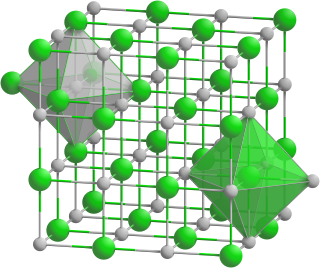
Sodium phosphide is the inorganic compound with the formula Na3P. It is a black solid. It is often described as Na+ salt of the P3− anion. Na3P is a source of the highly reactive phosphide anion. It should not be confused with sodium phosphate, Na3PO4.
Oxyphosphides are chemical compounds formally containing the group PO, with one phosphorus and one oxygen atom. The phosphorus and oxygen are not bound together as in phosphates or phosphine oxides, instead they are bound separately to the cations (metals), and could be considered as a mixed phosphide-oxide compound. So a compound with OmPn requires cations to balance a negative charge of 2m+3n. The cations will have charges of +2 or +3. The trications are often rare earth elements or actinides. They are in the category of oxy-pnictide compounds.
A Phosphide chloride is a mixed anion compound containing both phosphide (P3−) and chloride (Cl−) ions.
Phosphide silicides or silicide phosphides or silicophosphides are compounds containing anions composed of silicide (Si4−) and phosphide (P3−). They can be considered as mixed anion compounds. They are distinct from the phosphidosilicates, which have the phosphorus bonded to the silicon. Related compounds include the phosphide carbides, germanide phosphides, nitride silicides, and antimonide silicides.

Scandium phosphide is an inorganic compound of scandium and phosphorus with the chemical formula ScP.
Praseodymium phosphide is an inorganic compound of praseodymium and phosphorus with the chemical formula PrP. The compound forms crystals.
Europium phosphide is an inorganic compound of europium and phosphorus with the chemical formula EuP. Other phosphides are also known.
Samarium phosphide is an inorganic compound of samarium and phosphorus with the chemical formula SmP.
Thulium phosphide is an inorganic compound of thulium and phosphorus with the chemical formula TmP.
Bismuth phosphide is an inorganic compound of bismuth and phosphorus with the chemical formula BiP.
Holmium phosphide is a binary inorganic compound of holmium and phosphorus with the chemical formula HoP. The compound forms dark crystals and does not dissolve in water.
Dysprosium phosphide is an inorganic compound of dysprosium and phosphorus with the chemical formula DyP.

Terbium phosphide is an inorganic compound of terbium and phosphorus with the chemical formula TbP.
Plutonium phosphide is a binary inorganic compound of plutonium and phosphorus with the formula PuP.
Phosphide iodides or iodide phosphides are compounds containing anions composed of iodide (I−) and phosphide (P3−). They can be considered as mixed anion compounds. They are in the category of pnictidehalides. Related compounds include the phosphide chlorides, arsenide iodides antimonide iodides and phosphide bromides.
Phosphide bromides or bromide phosphides are compounds containing anions composed of bromide (Br−) and phosphide (P3−) anions. Usually phosphorus is covalently connected into more complex structures. They can be considered as mixed anion compounds. They are in the category of pnictidehalides. Related compounds include the phosphide chlorides, phosphide iodides, nitride bromides, arsenide bromides, and antimonide bromides.
Antimonide iodides or iodide antimonides are compounds containing anions composed of iodide (I−) and antimonide (Sb3−). They can be considered as mixed anion compounds. They are in the category of pnictide halides. Related compounds include the antimonide chlorides, antimonide bromides, phosphide iodides, and arsenide iodides.

Terbium compounds are compounds formed by the lanthanide metal terbium (Tb). Terbium generally exhibits the +3 oxidation state in these compounds, such as in TbCl3, Tb(NO3)3 and Tb(CH3COO)3. Compounds with terbium in the +4 oxidation state are also known, such as TbO2 and BaTbF6. Terbium can also form compounds in the 0, +1 and +2 oxidation states.
Samarium compounds are compounds formed by the lanthanide metal samarium (Sm). In these compounds, samarium generally exhibits the +3 oxidation state, such as SmCl3, Sm(NO3)3 and Sm(C2O4)3. Compounds with samarium in the +2 oxidation state are also known, for example SmI2.
Cobalt compounds are chemical compounds formed by cobalt with other elements.


